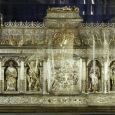Collegiate Church | XVIII | Neoclassical | Catholic Church



Map
Opening hours
01 January - 31 December
Mon -
Tue -
Wed -
Thu -
Fri -
Sat -
Sun -
Restoration work in progress: access to the church is impossible for an undetermined period.
Guided tour
+32 85 84 13 60
Religious offices
Saturday 6.30 pm
Sunday 10 am
Description
The imposing neo–classical collegial of Saint Begge built of Meuse limestone is in a beautiful calm square a little apart from the activity of the town. The grand façade has a square before it and is surrounded by patrician houses of which some belonged to the canons that were there from the Middle Ages up to the French revolution.
Saint Begge (pronounced Beche by people in the Ardennes) is the founder, around 692, of the first monastery and hence the town. She was the great grand-mother of Pepin the Short and the sister of Saint Gertrude of Nivelles.
The cult of the patron saint is evident on the inside. On the altar on the left there is a statue of the saint next to her tomb. As she was considered the protector of children, children’s shoes have been placed here and on the tomb to obtain protection and favours.
The church was built under the direction of Laurent-Benoit Dewez, official architect to the Austrian governor, Charles of Lorraine. It is sober and very bright, above all the chancel, which has been painted white. The nave and the sides are grey and await repainting.
At the end of the church is a painting of the massacre of the Innocents by Finsonius (1615), a pulpit, a lectern (1518), and six 19th century paintings depicting episodes in the life of the saint. The treasure and the museum in the annexe of the collegial has the reliquary of Saint Begge, ornaments, sculptures, manuscripts, jewellery, and religious porcelain from Andenne. Every quarter of an hour a fine carillon rings.
The collegial is listed as outstanding Wallonia patrimony.
Photos
Media
Remarkable elements
Sainte Begge / Dames de choeur - campagne 2021
Sur l’autel collatéral gauche, on admirera la statue de la sainte, à côté de son tombeau. Patronne de la Ville d’Andenne, sœur de Gertrude (Nivelles), Begge est considérée comme une protectrice des enfants.
Tomb of Saint Begge (12th century)
Blue stone slab supported by small statues of angels carrying censer and nuns. The many children's garments placed on the tomb are a touching reminder of the popular fervour with which Saint Begge is still associated.
Treasure and shrine of St. Begge
The 12 adjoining rooms of the building house the Treasure and Museum of the Collegiate Church. The collection includes a vast collection of silverware, of which the shrine of Saint Begge is one of the highlights.
Made between 1570 and 1645, it is often considered a masterpiece of Renaissance silverware. It consists of small niches with silver sculptures of the eleven apostles and St Paul. Bas-reliefs depicting the Entombment and the Resurrection appear in the middle of the sides, while the Adoration of the Shepherds and the Assumption adorn the gables.
Lectern
Brass lectern from a workshop in Maastricht, probably around 1520, which offers an alternative to traditional representations such as the eagle or the pelican. Here, a griffin is depicted, a fantastic animal with the beak, wings and talons of an eagle, the body of a lion, the ears of a horse and the tail of a snake.
Paintings depicting the life of Saint Begge
A series of 6 paintings by the Hague painter Isidore Lecrenier (1823-1889), commissioned between 1856 and 1858.
The Massacre of the Innocents
This gigantic painting, which is kept at the back of the nave, is the only one by the Bruges painter Louis Finson to be preserved in Belgium. Painted in 1615, the work presents a monumental composition divided into two main planes. The foreground is occupied by a multitude of characters, executioners and victims united in a dizzying chaos, while in the background stands out an architecture evoking Bethlehem.
The theatrical character of this work brings it closer to the Baroque movement.

























